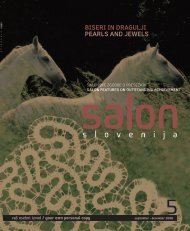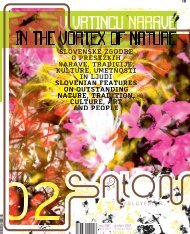You also want an ePaper? Increase the reach of your titles
YUMPU automatically turns print PDFs into web optimized ePapers that Google loves.
52<br />
Legenda | A legend<br />
53<br />
Rodil se je 22. decembra leta 1892 v Pulju v Istri (takratni<br />
Avstro-Ogrski, današnji Hrvaški). Oče, mornariški štabni častnik<br />
v avstro-ogrski mornarici, je umrl, ko je bilo Hermanu komaj 2<br />
leti. Takrat se je njegova mati z otroki preselila najprej v domače<br />
Vitanje na Štajersko in nato v Maribor, kjer je Herman preživel<br />
večji del otroštva. Sledila je vojaška tehniška akademija v<br />
Mödlingu pri Dunaju. Vojskovanje na moriščih 1. svetovne vojne<br />
mu je močno načelo zdravje, zbolel je namreč za jetiko. Po vojni<br />
je na dunajski univerzi vpisal študij strojništva in elektrotehnike<br />
in se po diplomi popolnoma posvetil raketni tehnologiji ter<br />
načrtovanju prodora v vesolje. A bolezen je terjala svoj davek;<br />
Herman je umrl zaradi pljučnice, star komaj 37 let.<br />
Leta 2006 so v Vitanju na Štajerskem, kjer je Potočnik preživel nekaj otroških let, odprli spominsko središče<br />
In 2006 a memorial centre was opened in Vitanje, Styria, where Potočnik had spent some of his childhood years<br />
Malo pred smrtjo, leta 1928, je dokončal svojo edino knjigo<br />
»Problem vožnje po vesolju – raketni motor« z originalnim<br />
naslovom »Das Problem der Befahrung des Weltraums<br />
– der Raketen motor«, ki mu je zaradi vizionarskih idej in<br />
znanstvenega dela prinesla nesmrtnost. Knjiga, katero je izdal<br />
pod psevdonimom Herman Noordung, obsega 188 strani in<br />
vsebuje 100 avtorjevih ilustracij ter predstavlja eno temeljnih<br />
del pionirske astronavtike.<br />
V knjigi je Potočnik podrobno predstavil načrt prodora v<br />
vesolje vključno z geostacionarnim satelitom, vesoljskim<br />
stanovanjskim kolesom, valjastim observatorijem in sončno<br />
toplotno-mehansko-električno energetsko centralo. Poleg<br />
načrta stalno naseljene vesoljske postaje, ki je takrat med<br />
množicami veljala za znanstveno fantastiko, je obravnaval tudi<br />
obletavanja Zemlje po breztežnostni krožnici, problem bivanja<br />
v vesolju, izstrelitev, polet in vrnitev vesoljske rakete. Tako je<br />
pravilno izračunal in predvidel vse faze poleta okrog Zemlje<br />
več kot 30 let pred prvim poletom človeka v vesolje. Pravilnost<br />
Potočnikovih izračunov potrjujejo tudi besede ruskega<br />
astronavta in trojnega doktorja znanosti Jurija Baturina, ki je<br />
dejal: »Točno tako kot Potočnik opisuje polet, sem sam poletel v<br />
vesolje dvakrat.«<br />
Herman Potočnik was born on 22 December 1892 in Pulj, Istria (then<br />
Austrian-Hungarian Empire, present Croatia). His father, a naval officer<br />
in the Austrian-Hungarian navy, died when Herman was but two years<br />
old. Herman’s mother took the children first to her home village of Vitanje,<br />
Styria, and then to Maribor, where Herman spent the greater part of his<br />
childhood. His next stop was the Technical Military Academy at Mödling<br />
near Vienna. Fighting in the battlefields of World War I severely degraded<br />
his health and he was soon diagnosed with consumption. After the war<br />
he studied mechanical and electrical engineering at the Vienna university.<br />
After graduation he completely devoted himself to rocket science and<br />
pioneering work in space travel. Unfortunately, his poor health took its toll<br />
and Herman died of pneumonia at 37.<br />
Shortly before his death, in 1928 he outlined his visionary ideas and<br />
backed them up by science in his only book, “The Problem of Space<br />
Travel – The Rocket Motor” (originally published under the pseudonym<br />
Herman Noordung under the title “Das Problem der Befahrung<br />
des Weltraums – der Raketen Motor”), which basically ensured his<br />
immortality. The 188-page book, which features 100 illustrations<br />
by the author, is considered one of the fundamental works<br />
in early astronautics.<br />
In the book Potočnik outlined a detailed plan of setting out into space<br />
complete with geostationary satellite, space residential module,<br />
cylindrical observatory, and solar thermal-mechanical-electrical power<br />
station. In addition to proposing the design for a permanently manned<br />
space station, which the masses at the time regarded as pure science<br />
fiction, he also addressed weightless travel in orbit around the Earth,<br />
the problem of residing in space as well as the launch, travel and<br />
return to Earth of a space rocket. He produced exact calculations and<br />
flawlessly envisaged all stages of a flight around the Earth more than<br />
30 years ahead of man’s first voyage into space. The accuracy of<br />
Potočnik’s calculations has also been confirmed by Russian astronaut<br />
and triple PhD Yuri Baturin, who has stated, “I have flown into space<br />
twice myself exactly as described by Potočnik.”<br />
Izjemnost Potočnikovega dela in<br />
njegov vpliv na razvoj astronavtike<br />
Njegova knjiga je ena izmed<br />
osnovnih referenc doktorata<br />
nemškega pionirja astronavtike<br />
Werneherja von Brauna iz leta<br />
1934. Von Braun je bil kasneje<br />
ključna oseba razvoja nemške<br />
raketne tehnologije pred in med<br />
drugo svetovno vojno ter glavni<br />
kreator prvih ameriških korakov<br />
pri osvajanju vesolja. Von Braun,<br />
ki je leta 1958 tudi vodil izstrelitev<br />
prvega umetnega (ameriškega)<br />
satelita, je o knjigi zapisal, da je<br />
bila »učbenik graditeljem vesoljskih<br />
vozil« in »prelomnica v svetovni<br />
vesoljski raketni tehniki«. Potočnika<br />
je hkrati uvrstil »med pionirje, ki so<br />
prispevali levji delež k realizaciji<br />
vesoljskega programa«.<br />
Potočnikovi načrti so bili tudi navdih pri<br />
oblikovanju številnih konceptov vesoljskih<br />
postaj, predvsem v petdesetih in<br />
šestdesetih letih. Med njimi tudi ene izmed<br />
ikon znanstvene fantastike filma Odiseja<br />
2001 (2001: A Space Odyssey) iz leta<br />
1968, režiserja Stanleya Kubricka, po<br />
scenariju Kubricka in Arthurja C. Clarkea.<br />
Potočnik’s models also proved a source<br />
of inspiration to numerous space station<br />
conceptual designs, in particular in the<br />
1950s and 1960s, including the one used<br />
in the legendary Sci-Fi film, 2001: A Space<br />
Odyssey from 1968 directed by Stanley<br />
Kubric and written by Kubric and<br />
Arthur C. Clarke.<br />
The uniqueness of Potočnik’s work<br />
and his impact on the development<br />
of astronautics<br />
His book is quoted as a basic<br />
reference in the 1934 PhD thesis of<br />
the German pioneer in astronautics,<br />
Wernher von Braun. Later on,<br />
Von Braun played a crucial role in<br />
the development of the German<br />
rocket technology before and<br />
during World War II, and was the<br />
principal creator of the first US<br />
steps towards conquering space.<br />
Von Braun, who was in charge of<br />
the launch of the first manmade<br />
(US) satellite in 1958, described<br />
Potočnik’s work as “a textbook<br />
for the builders of space vehicles”<br />
and “a milestone in the world<br />
space rocket science”. He counted<br />
Potočnik “among the pioneers who<br />
have contributed a lion’s share<br />
towards the realisation of the<br />
space programme.”<br />
Legendarni pisatelj znanstvene fantastike<br />
Arthur C. Clarke, ki je leta 1945 prvi<br />
predlagal uporabo geostacionarnih<br />
satelitov za komunikacijske namene, je<br />
prav tako potrdil, da je prve inženirske<br />
načrte vesoljske postaje na breztežnostni<br />
krožnici izdelal prav Potočnik.<br />
Legendary science fiction writer Arthur<br />
C. Clarke, who was the first to propose<br />
the use of geostationary satellites for<br />
communication purposes in 1950, likewise<br />
confirmed that it was Potočnik who had<br />
produced the first orbiting space station<br />
engineering designs.<br />
To je samo nekaj navedb, ki opisujejo delo in dosežke tega dolgo<br />
prezrtega moža iz zgodovine znanosti, po katerem so poimenovali<br />
tudi enega izmed asteroidov. Žal ni uspela pobuda, da bi po njem<br />
poimenovali mednarodno vesoljsko postajo. S prevodom svoje knjige v<br />
angleščino, s strani ameriške vesoljske agencije NASA, leta 1995, pa je<br />
dobil tudi zaslužen poklon s strani mednarodne javnosti. Leta 2006 so v<br />
Vitanju na Štajerskem, kjer je Potočnik preživel nekaj otroških let, odprli<br />
spominsko središče.<br />
These are just a few examples illustrating the work and achievements<br />
of the man long overlooked by the history of science, whose name also<br />
graces one of the asteroids. Unfortunately, the initiative for a space<br />
station to be named after Potočnik, did not succeed. By translating<br />
his book into English in 1995, however, the US space agency NASA<br />
acknowledged his contribution and gave it due recognition in the<br />
international arena. In 2006 a memorial centre was opened in Vitanje,<br />
Styria, where Potočnik had spent some of his childhood years.<br />
Revija Salon Slovenija Magazine<br />
Noordungova ilustracija vesoljske postaje<br />
Noordung's illustration of a space station







